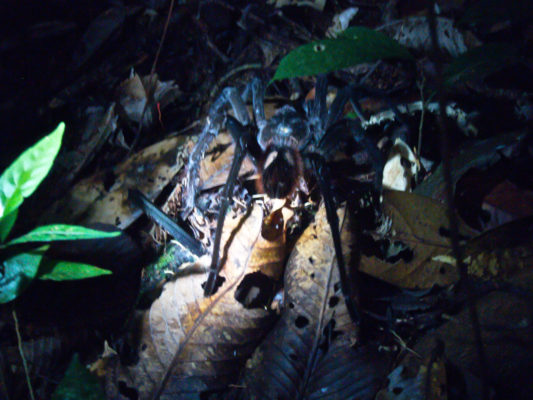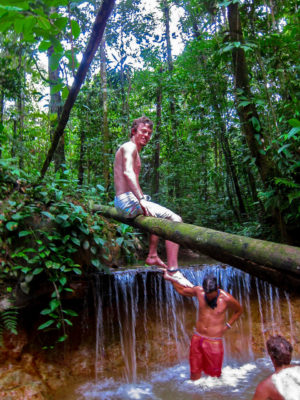Destination Amazon Basin with Amazon Jungle Trips
It wasn’t long before we spotted wild macaw parrots flying above us as we set out down the flooded Amazon River from Leticia, a town located on the southern tip of Colombia. We had travelled from Medellin on a LAN Airlines flight to embark on a five-day journey throughout the great Amazon Basin of not only Colombia, but Peru and Brazil as well.
Bluetooth speakers playing, towels thrown down to lay on, and fresh air from the lungs of the earth – this was an experience that would last for years to come. Teaming with life in and out of the waters, the ecosystem around Leticia is thriving, preserved and largely protected. Unlike other experiences we had heard from travellers who explored the Amazon in other countries, we didn’t see any oil tankers, deforestation, or pollution. It was as if we were in a national park the entire time.
Departing Leticia the first day
Amazon River, Colombia
Looking onto the flooded Peru boarder
Amazon River, Colombia
Our first stop was at an indigenous village that shared cultural dances and sold trinkets and other crafts. We sympathetically purchased some knowing that it’s one of the few ways they can make money from tourists passing through their communities. Two nights of our trip were spent at a lodge, another night with the indigenous village and one in the jungle with hammocks. Each night served up a different experience that made the trip unique and authentic. Trekking through the jungle was an experience on its own – we met with locals who acted as our guides, rifles and machetes in hand ready to defend us if needed and chop any debris that filled in the trail. In defence of the mosquitos, we had the strongest DEET money could buy (cancer risk taken, the mosquitoes are THAT bad in the Amazon) and were dressed head to toe in long sleeves and pants. In defence of poisonous reptiles that may be lurking on the trail below, we had tall rubber boots. And lastly in defence of larger and stronger potentially vicious animals, we had our guides. Pointing out the flora and fauna of the forest, our guides took us through the forest while monkeys jumped from the trees above. Unworldly sounds came from every direction – exotic birds squawking, bushes rustling – this place is truly alive. Dense and fresh, these forests are said to absorb the most carbon dioxide and produce the most oxygen of any other forest on earth. We came to our destination near a creek and our guides set up a camp comprised of hammocks, bug nets, and a shelter over the hammocks for rain. After a hearty dinner, we went on a walk to explore the nocturnal creatures of the night, some consisting of ice cream bucket-size spiders.


Hammock City
Amazon River, Colombia
BBQ chicken in the jungle
Amazon Jungle, Colombia
At morning we hiked back to the river where our boat and Capitán awaited – it was a welcomed sight that meant we could rest inside the boat as it took us down the river to our next location.
We continued to be lost in curiosity as our boat took a turn down a narrow passage through the forest. It was as if someone had carved a road through the trees, barely wide enough for two boats to pass each other. Travelling the Amazon during flood season is actually the best time to be there – and it was a complete coincidence that we were there at that time. Flood season means that boats can carve through the forest roads, destinations are more accessible, and the animals are all in the trees, easy to spot while they wait for the waters to recede. As we veered through the jungle, we looked above to see monkeys swinging through the trees, and below to see the same trees and other plants descend into the depths of the river as their green submerged leaves disappeared into the abyss. En route to our lodge, we saw more wildlife including an iguana, sloth, and tarantula, all hiding out in the trees above the river. Our captain and guide led us further into the forest, twisting and turning onto other jungle-river-roadways until we arrived at our lodge, which would be home for the next two nights. Shortly after we arrived, a sunset to remember lit up the sky.
Sunset on the Amazon River
Amazon River, Brazil
Iguana hiding from the flooded Amazon River
Amazon Jungle
We pulled up to our lodge, which sat perched above the flowing river – essentially a rugged version of a Bora Bora above-ocean hut but Amazon style. After relaxing and having dinner, our guide led us back into the boat for another nocturnal adventure, this time involving large reptiles. Cayman alligators are native to much of Central and South America as well as the Caribbean islands, and deep in the flooded forest, they lurked, eyes perched just barely above the water and reflecting in the guide’s flashlight. The big ones were deep in the forest, and we could tell they were big. Our guide and some locals called to them by making a deep throat and neck movement, “URPH – URPH – URPH” – we waited. URPH – URPH – URPH – they called back. It was the deepest and meanest sound we had heard come from the forest, and their sounds echoed from the deep dark depths. They had no interest in us, but outside of the thick jungle where we floated were the baby caymans which our guides caught with their bare hands to show us before releasing them back.
We explored the area for the next full day, piranha fishing, wildlife viewing and rowing our own small boats at leisure. On the last day it was time to head back to Leticia, but not before spotting the rare and friendly pink and grey dolphins. We again floated through the forest on a small clear river that eventually joined the larger murky Amazon River. Where the two waters joined, the pink and grey dolphins met us and surfaced around us. As we headed back to Leticia on the large Amazon River, two of us happened to be looking up at the river while everyone laid and snoozed – to cap off an unforgettable experience, a grey dolphin jumped two meters out of the river, floundering in the air – only the two of us witnessed this display and it was something we’ll never forget.
Self-exploring in the Amazon
Amazon River
Amazon Pink Dolphins paying us a visit
Amazon River, Peru
Recommended Tour Companies
Trips similar to the one described above can be booked with Amazon Jungle Trips (AJT) in Leticia. They offer three to five-day tours that involve lodge stays at Zacambu Rainforest Lodge and can be paired with the same overnight camping excursion described in this post. AJT offers a sustainability guarantee that states, “The operation of our lodges and our tours produce no negative impacts on the surrounding environment. We provide sustainability education to our employees and the local populations surrounding our lodges, encouraging them to implement sustainability practices in their daily lives.” Amazon Jungle Tours ensure their activities will be enjoyed without damaging the environment or the local communities so the future generations can enjoy the same opportunities in years to come.
Another tour company in the area is Amazonas Jungle Tours, which are highly regarded online.
When to go
For the best chance of spotting wildlife and exploring the largest forest area, visiting in the rainy season is recommended. The wet season runs from January to June and the river can reach peak levels in late April/May (as it did for us). For more information on the benefits of visiting during different seasons, see this in-depth article.
Tips for booking with LAN Airlines
LAN is known to track search data and IP addresses and so when booking it is common to see the flight to up more and more every time you look. A way to avoid this is to download a VPN such as Hola for Google Chrome and search from a different country to find competitive pricing on tickets.
Author: Eco Escape Travel | Date: February 21, 2023

